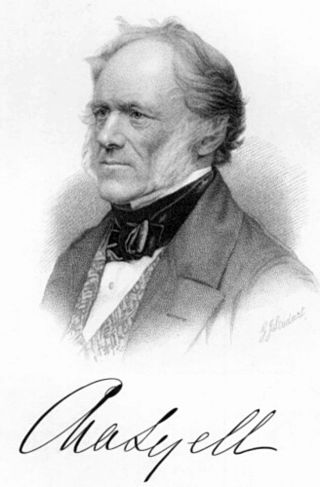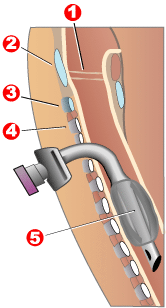
Sir Charles Lyell, 1st Baronet, was a Scottish geologist who demonstrated the power of known natural causes in explaining the earth's history. He is best known today for his association with Charles Darwin and as the author of Principles of Geology (1830–33), which presented to a wide public audience the idea that the earth was shaped by the same natural processes still in operation today, operating at similar intensities. The philosopher William Whewell dubbed this gradualistic view "uniformitarianism" and contrasted it with catastrophism, which had been championed by Georges Cuvier and was better accepted in Europe. The combination of evidence and eloquence in Principles convinced a wide range of readers of the significance of "deep time" for understanding the earth and environment.
1858 (MDCCCLVIII) was a common year starting on Friday of the Gregorian calendar and a common year starting on Wednesday of the Julian calendar, the 1858th year of the Common Era (CE) and Anno Domini (AD) designations, the 858th year of the 2nd millennium, the 58th year of the 19th century, and the 9th year of the 1850s decade. As of the start of 1858, the Gregorian calendar was 12 days ahead of the Julian calendar, which remained in localized use until 1923.

August Ferdinand Möbius was a German mathematician and theoretical astronomer.

Tracheal intubation, usually simply referred to as intubation, is the placement of a flexible plastic tube into the trachea (windpipe) to maintain an open airway or to serve as a conduit through which to administer certain drugs. It is frequently performed in critically injured, ill, or anesthetized patients to facilitate ventilation of the lungs, including mechanical ventilation, and to prevent the possibility of asphyxiation or airway obstruction.
The year 1881 in science and technology involved some significant events, listed below.

Tracheotomy, or tracheostomy, is a surgical airway management procedure which consists of making an incision (cut) on the anterior aspect (front) of the neck and opening a direct airway through an incision in the trachea (windpipe). The resulting stoma (hole) can serve independently as an airway or as a site for a tracheal tube or tracheostomy tube to be inserted; this tube allows a person to breathe without the use of the nose or mouth.

Arthur Cayley was a British mathematician who worked mostly on algebra. He helped found the modern British school of pure mathematics.
The year 1909 in science and technology involved some significant events, listed below.
The year 1912 in science and technology involved some significant events, listed below.
The year 1872 in science and technology involved some significant events, listed below.
The year 1882 in science and technology involved some significant events, listed below.
The year 1868 in science and technology involved some significant events, listed below.
The year 1859 in science and technology involved some significant events, listed below.
The year 1854 in science and technology involved some significant events, listed below.
The year 1852 in science and technology involved some significant events, listed below.

Joseph O'Dwyer was an American physician. He developed a valuable system of intubation in diphtheria cases. O'Dwyer is often cited as the "father of laryngeal intubation in croup".

John Joseph Bennett was a British physician and botanist. He was the younger brother of the zoologist Edward Turner Bennett.

Eugène Bouchut was a French physician born in Paris. He made significant contributions in several medical fields, including pediatrics, laryngology, neurology and ophthalmology.
The following is a timeline of key developments of geometry:
Tracheal intubation, an invasive medical procedure, is the placement of a flexible plastic catheter into the trachea. For millennia, tracheotomy was considered the most reliable method of tracheal intubation. By the late 19th century, advances in the sciences of anatomy and physiology, as well as the beginnings of an appreciation of the germ theory of disease, had reduced the morbidity and mortality of this operation to a more acceptable rate. Also in the late 19th century, advances in endoscopic instrumentation had improved to such a degree that direct laryngoscopy had finally become a viable means to secure the airway by the non-surgical orotracheal route. Nasotracheal intubation was not widely practiced until the early 20th century. The 20th century saw the transformation of the practices of tracheotomy, endoscopy and non-surgical tracheal intubation from rarely employed procedures to essential components of the practices of anesthesia, critical care medicine, emergency medicine, gastroenterology, pulmonology and surgery.








